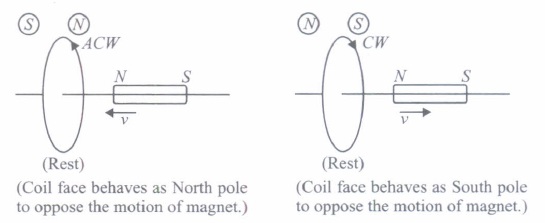Class 12th Physics - Electromagnetic Induction Case Study Questions and Answers 2022 - 2023
By QB365
QB365 provides a detailed and simple solution for every Possible Case Study Questions in Class 12th Physics Subject - Electromagnetic Induction, CBSE. It will help Students to get more practice questions, Students can Practice these question papers in addition to score best marks.
QB365 - Question Bank Software
Electromagnetic Induction Case Study Questions With Answer Key
12th Standard CBSE
-
Reg.No. :
Physics
-
Lenz's law states that the direction of induced current in a circuit is such that it opposes the change which produces it. Thus, if the magnetic flux linked with a closed circuit increases, the induced current flows in such a direction that magnetic flux is created in the opposite direction of the original magnetic flux. If the magnetic flux linked with the closed circuit decreases, the induced current flows in such a direction so as to create magnetic flux in the direction of the original flux.

(i) Which of the following statements is correct?(a) The induced e.m.f is not in the direction opposing the change in magnetic flux so as to oppose the cause which produces it. (b) The relative motion between the coil and magnet produces change in magnetic flux. (c) Emf is induced only if the magnet is moved towards coil. (d) Emf is induced only if the coil is moved towards magnet (ii) The polarity of induced emf is given by
(a) Ampere's circuital law (b) Biot-Savart law (c) Lenz's law (d) Fleming's right hand rule (iii) Lenz's law is a consequence of the law of conservation of
(a) charge (b) mass (c) momentum (d) energy (iv) Near a circular loop of conducting wire as shown in the figure, an electron moves along a straight line. The direction of the induced current if any in the loop is

(a) variable (b) clockwise (c) anticlockwise (d) zero (v) Two identical circular coils A and B are kept in a horizontal tube side by side without touching each other. If the current in coil A increases with time, in response, the coil B.
(a) is attracted by A (c) is repelled (c) is repelled (d) rotates (a) -
Mutual inductance is the phenomenon of inducing emf in a coil, due to a change of current in the neighbouring coil. The amount of mutual inductance that links one coil to another depends very much on the relative positioning of the two coils, their geometry and relative separation between them. Mutual inductance between the two coils increases \(\mu_{r}\) times if the coils are wound over an iron core of relative permeability \(\mu_{r}\).

(I) A short solenoid of radius a, number of turns per unit length nI' and length L is kept coaxially inside a very long solenoid of radius b, numbdr of turns per unit length n2• What is the mutual inductance of the system?\(\text { (a) } \mu_{0} \pi b^{2} n_{1} n_{2} L\) \(\text { (b) } \mu_{0} \pi a^{2} n_{1} n_{2} L^{2}\) \(\text { (c) } \mu_{0} \pi a^{2} n_{1} n_{2} L\) \(\text { (d) } \mu_{0} \pi b^{2} n_{1} n_{2} L^{2}\) (ii) If a change in current of 0.01 A in one coil produces a change in magnetic flux of 2 x l0-2 weber in another coil, then the mutual inductance between coils is
(a) 0 (b) 0.5 H (c) 2 H (d) 3 H (iii) Mutual inductance of two coils can be increased by
(a) decreasing the number of turns in the coils (b) increasing the number of turns in the coils (c) winding the coils on wooden cores (d) none of these (iv) When a sheet of iron is placed in between the two co-axial coils, then the mutual inductance between the coils will
(a) increase (b) decrease (c) remains same (d) cannot be predicted (v) The SI unit of mutual inductance is
(a) ohm (b) mho (c) henry (d) none of these (a) -
Currents can be induced not only in conducting coils, but also in conducting sheets or blocks. Current is induced in solid metallic masses when the magnetic flux threading through them changes. Such currents flow in the form of irregularly shaped loops throughout the body of the metal. These currents look like eddies or whirlpools in water so they are known as eddy currents. Eddy currents have both undesirable effects and practically useful applications. For example it causes unnecessary heating and wastage of power in electric motors, dynamos and in the cores of transformers.
(I) The working of speedometers of trains is based on(a) wattless currents (b) eddy currents (c) alternating currents (d) pulsating currents (ii) Identify the wrong statement
(a) Eddy currents are produced in a steady magnetic field (b) Induction furnace uses eddy currents to produce heat. (c) Eddy currents can be used to produce braking force in moving trains (d) Power meters work on the principle of eddy currents. (iii) Which of the following is the best method to reduce eddy currents?
(a) Laminating core (b) Using thick wires (c) By reducing hysteresis loss (d) None ofthese (iv) The direction of eddy currents is given by
(a) Fleming's left hand rule (b) Biot-Savart law (c) Lenz's law (d) Ampere-circuital law (v) Eddy currents can be used to heat localised tissues of the human body. This branch of medical therapy is called
(a) Hyperthermia (b) Diathermy (c) Inductothermy (d) none of these (a) -
When a current I flows through a coil, flux linked with it is \(\phi=L I,\) where L is a constant known as self-inductance of the coil. Any change in current sets up an induced emf in the coil. Thus, self-inductance of a coil is the induced emf set up in it when the current passing through it changes at the unit rate. It is a measure of the opposition to the growth or the decay of current flowing through the coil. Also, value of self-inductance depends on the number of turns in the solenoid, its area of cross-section, and the relative permeability of its core material.

(I) The inductance in a coil plays the same role as(a) inertia in mechanics (b) energy in mechanics (c) momentum in mechanics (d) force in mechanics (ii) A current of 2.5 A flows through a coil of inductance 5 H. The magnetic flux linked with the coil is
(a) 0.5 Wb (b) 12.5 Wb (c) zero (d) 2 Wb (iii) The inductance L of a solenoid depends upon its radius R as
\(\text { (a) } L \propto R\) \(\text { (b) } L \propto 1 / R\) \(\text { (c) } L \propto R^{2}\) \(\text { (d) } L \propto R^{3}\) (iv) The unit of self-inductance is
(a) weber ampere (b) weber-1 ampere (c) ohm second (d) farad (v) The induced e.m.f in a coil of 10 henry inductance in which current varies from 9 A to 4 A in 0.2 second is
(a) 200 V (b) 250 V (c) 300 V (d) 350 V (a) -
In year 1820 Oersted discovered the magnetic effect of current. Faraday gave the thought that reverse of this phenomenon is also possible i.e., current can also be produced by magnetic field. Faraday showed that when we move a magnet towards the coil which is connected by a sensitive galvanometer. The galvanometer gives instantaneous deflection showing that there is an electric current in the loop.
Whenever relative motion between coil and magnet takes place an emf induced in coil. If coil is in closed circuit then current is also induced in the circuit. This phenomenon is called electromagnetic induction.

(I) The north pole of a long bar magnet was pushed slowly into a short solenoid connected to a galvanometer. The magnet was held stationary for a few seconds with the north pole in the middle of the solenoid and then withdrawn rapidly. The maximum deflection of the galvanometer was observed when the magnet was(a) moving towards the solenoid (b) moving into the solenoid (c) at rest inside the solenoid (d) moving out of the solenoid. (ii) Two similar circular loops carry equal currents in the same direction. On moving the coils further apart, the electric current will
(a) remain unaltered (b) increases in one and decreases in the second (c) increase in both (d) decrease in both (iii) A closed iron ring is held horizontally and a bar magnet is dropped through the ring with its length along the axis of the ring. The acceleration of the falling magnet is
(a) equal to g (b) less than g (c) more than g (d) depends on the diameter of the ring and length of magnet (iv) Whenever there is a relative motion between a coil and a magnet, the magnitude of induced emf set up in the coil does not depend upon the
(a) relative speed between the coil and magnet (b) magnetic moment of the coil (c) resistance of the coil (d) number of turns in the coil (v) A coil of metal wire is kept stationary in a non-uniform magnetic field
(a) an emf and current both are induced in the coil (b) a current but no emf is induced in the coil (c) an emf but no current is induced in the coil (d) neither emf nor current is induced in the coil (a) -
The emf induced across the ends of a conductor due to its motion in a magnetic field is called motional emf. It is produced due to the magnetic Lorentz force acting on the free electrons of the conductor. For a circuit shown in figure, if a conductor of length I moves with velocity v in a magnetic field B perpendicular to both its length and the direction of the magnetic field, then all the induced parametres are possible in the circuit.

(i) Direction of current induced in a wire moving in a magnetic field is found using(a) Fleming's left hand rule (b) Fleming's right hand rule (c) Ampere's rule (d) Right hand clasp rule (ii) A conducting rod of length I is moving in a transverse magnetic field of strength B with velocity v. The resistance of the rod is R. The current in the rod is
\(\text { (a) } \frac{B l v}{R}\) (b) Blv (c) zero \(\text { (d) } \frac{B^{2} v^{2} l^{2}}{R}\) (iii) A 0.1 m long conductor carrying a current of 50 A is held perpendicular to a magnetic field of 1.25 mT. The mechanical power required to move the conductor with a speed of 1 m s-1 is
(a) 62.5 mW (b) 625 mW (c) 6.25 mW (d) 12.5 mW (iv) A bicycle generator creates 1.5 V at 15 km/hr. The EMF generated at 10 km/hr is
(a) 1.5 volts (b) 2volts (c) 0.5volts (d) 1 volt (v) The dimensional formula for emf E in MKS system will be
\(\text { (a) }\left[\mathrm{ML}^{2} \mathrm{~T}^{-3} \mathrm{~A}^{-1}\right]\) \(\text { (b) }\left[\mathrm{ML}^{2} \mathrm{~T}^{-1} \mathrm{~A}\right]\) \(\text { (c) }\left[\mathrm{ML}^{2} \mathrm{~A}\right]\) \(\text { (d) }\left[\mathrm{MLT}^{-2} \mathrm{~A}^{-2}\right]\) (a) -
An inductor is simply a coil or a solenoid that has a fixed inductance. It is referred to as a choke. The usual circuit notation for an inductor is as shown.

Let a current i flows through the inductor from A to B. Whenever electric current changes through it, a back emf is generated. If the resistance of inductor is assumed to be zero (ideal inductor) then induced emf in it is given by
\(e=V_{B}-V_{A}=-L \frac{d i}{d t}\)
Thus, potential drops across an inductor as we move in the direction of current. But potential also drops across a pure resistor when we move in the direction of the current.
The main difference between a resistor and an inductor is that while a resistor opposes the current through it, an inductor opposes the change in current through it.
Now -answer the following questions.
(i) How does inductor behave when
(a) a steady current flow through it?
(b) a steadily increasing, current flows through it?
(c) a steadily decreasing current flows through it?
(ii) The network shown in the figure is part of a complete circuit. If at a certain instant of time the current (I) is 5A and is decreasing at a rate of 10 3 A/s, find out VB - VA.
 (a)
(a) -
A solenoid is held in a vertical position. The solenoid is connected to a sensitive, centre-zero ammeter.
A vertical bar magnet is held stationary at position X just above the upper end ofthe solenoid as shown.

The magnet is released and it falls through the solenoid. During the initial stage of the fall, the sensitive ammeter shows a small deflection to the left
(i) Explain why the ammeter shows a deflection.
(ii) The magnet passes the middle point of the solenoid and continues to fall. It reaches position Y. Describe and explain what is observed on the ammeter as the magnet falls from the middle point of the solenoid to position Y.
(iii) Suggest two changes in the apparatus that would increase the initial deflection of the ammeter(a) -
A very small circular loop of area 5 x 10-4 cm 2 with resistance 4\(\Omega\) is placed such that it is concentric and in the same plane with another loop of radius 10 cm. A constant current of 2A is passed in the bigger loop, which is rotated with angular speed of \(\omega\) rad S-1, about its diameter. The magnetic field produced due to the bigger loop provides magnetic flux, which is linked with smaller loop.
(i) Determine magnetic field at the centre.
(ii) Determine magnetic flux linked with smaller loop.
(iii) What is the value of induced emf and current in the smaller loop as a function of time.(a)
Case Study
*****************************************
Answers































